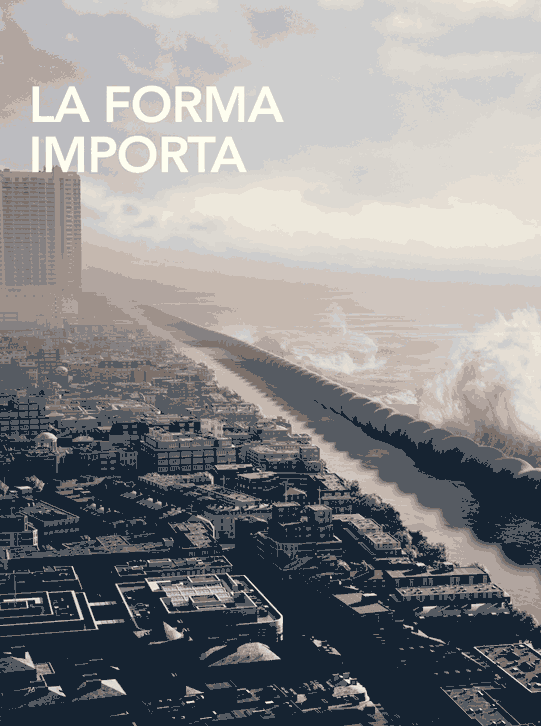La forma importa
Barra lateral del artículo

Palabras clave:
Contenido principal del artículo
Resumen
A través de la historia, los maestros de la construcción han dado pasos significativos en el aprovechamiento de formas para definir espacios tridimensionales, para proporcionar refugio y protección o hacer puentes sobre vacíos, como los ocasionados por los cursos de agua y los caminos. En ausencia de métodos de predicción numérica, ellos debieron desarrollar prácticas de construcción por medio del ensayo y el error o teorías estructurales para establecer una forma estructural “suficientemente buena”. Actualmente, experimentamos un renacimiento de las formas libres como expresión arquitectónica; sin embargo, el desempeño estructural como principal impulsor del diseño es a menudo excluido del proceso inicial de diseño. La investigación del Form Finding Lab (Universidad de Princeton, EE.UU.) puede ubicarse en la tradición del modelado a base de fuerzas, indagando nuevas estrategias numéricas para generar formas estructurales únicas de vanguardia. Aquí se presentan tres estudios que muestran el desarrollo de esas técnicas, las que, cuando se emplean con procesos constructivos bien ejecutados, producen formas sorprendentes para puentes peatonales, cubiertas y barreras.
Abstract
Master builders throughout history have made significant strides in exploiting forms to enclose three-dimensional spaces, to provide shelter and protection or to bridge voids, such as water and roadways. In the absence of numerical prediction methods, they resorted to trial and error construction practices or structural theory to establish a good enough structural form. Today, we experience a renaissance of free forms as an architectural expression. Yet, structural performance as the main design driver is often excluded from the initial design process. The scholarship at the Form Finding Lab (Princeton University, USA) can be placed in a force-modelled tradition by pioneering novel numerical structural form generation approaches and unique structural performative forms. Three studies are presented that showcase the development of such techniques, which when craftfully manipulated, result in surprising shapes for structurally efficient footbridges, roofs and barriers.
Detalles del artículo
Materia Arquitectura proporciona acceso inmediato y gratuito a todos los contenidos de esta edición electrónica, publicada simultáneamente con la edición impresa. Materia Arquitectura no cobra honorarios a los autores por ningún concepto.
Todos los contenidos de esta edición electrónica se distribuyen bajo licencia Creative Commons de “Atribución-Copartirigual 4.0 Internacional” (CC-BY-SA).
La licencia Creative Commons permite el acceso libre e inmediato al contenido y permite que cualquier usuario lea, descargue, copie, distribuya, imprima, busque o genere enlaces a los textos completos de los artículos, permitiendo también que estos puedan ser rastreados para indexarlos, pasarlos como datos a software o usarlos para cualquier otro propósito legal. Asimismo, la licencia otorga derechos de uso a quienes a su vez utilicen una licencia abierta (Creative Commons o equivalente).
Los derechos de los textos y las imágenes publicadas pertenecen a sus autores, quienes otorgan a Materia Arquitectura la licencia para su uso. La gestión de los permisos y la autorización de publicación de las imágenes (o de cualquier material) que contenga derechos de autor y sus consecuentes derechos de reproducción en esta publicación es de exclusiva responsabilidad de los autores de los artículos.
Toda vez que mencionen su origen, los autores son libres de distribuir sus artículos por otros medios. Cualquier reproducción total o parcial del material deberá citar su procedencia.
Descargas
Citas
ADRIAENSSENS, S., BLOCK, P., VEENENDAAL, D., & WILLIAMS, C. (2014). Shell structures for architecture: Form finding and optimization. Londres, Inglaterra: Routledge.
ADRIAENSSENS, S., GABRIELE, S., MAGRONE, P., & VARANO, V. (2016). Revisiting the form finding techniques of Sergio Musmeci: The Bridge over the Basento River. 3rd International Conference on Structures and Architecture (ICSA) 2016, Guimares, Portugal (págs. 543-550).
BARNES, M. R., ADRIAENSSENS, S., & KRUPKA, M. (2013). A novel torsion/bending element for dynamic relaxation modeling. Computers & Structures, 119, 60-67.
HALPERN, A. B., & ADRIAENSSENS, S. (2014). Nonlinear elastic in-plane buckling of shallow truss arches. Journal of Bridge Engineering, 20(10), 04014117.
HALPERN, A. B., & ADRIAENSSENS, S. (2015). In-plane optimization of truss arch footbridges using stability and serviceability objective functions. Structural and Multidisciplinary Optimization, 51(4), 971-985.
HOOKE, R. (1676). A description of Helioscopes and Some Other Instruments Made by Robert Hooke (Vol. 65). Londres, Inglaterra: J. Martyn.
MUSMECI, S. (1980). Struttura ed architettura. L’Industria Italiana del Cemento(10), 771-786.
NERVI, P. L. (1955). Costruire correttamente. Milán, Italia: Hoepli.
RICHARDSON, J. N., ADRIAENSSENS, S., COELHO, R. F., & BOUILLARD, P. (2013). Coupled form-finding and grid optimization approach for single layer grid shells. Engineering structures, 52, 230-239.
STREETER, M., RHODE-BARBARIGOS, L., & ADRIAENSSENS, S. (2015). Form finding and analysis of inflatable dams using dynamic relaxation. Applied Mathematics and Computation, 267, 742-749.
TYSMANS, T., ADRIAENSSENS, S., & WASTIELS, J. (2011). Form finding methodology for force-modelled anticlastic shells in glass fibre textile reinforced cement composites. Engineering Structures, 33(9), 2603-2611.
Artículos más leídos del mismo autor/a
- Sigrid Adriaenssens, Form Matters , Materia Arquitectura: Núm. 13 (2016): Materia Arquitectura 13 (Agosto/August 2016)